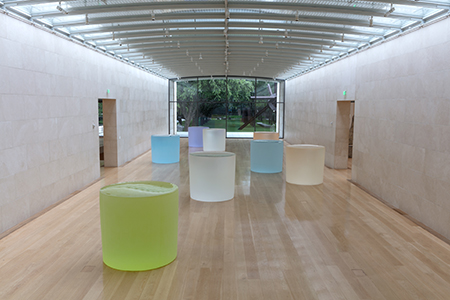
Continuing through August 20, 2017
Seven large-scale sculptures by American artist Roni Horn (b. 1955) are each in a distinct color that glows with luminous intensity. This is Horn’s first museum exhibition in the U.S. since 2010, and the first time these particular glass sculptures, the largest yet, have been seen in public. Additionally, this is the first museum showcase to focus solely on her cast glass sculpture. Their delicate surfaces deceptively belie an immense weight, each one at about five tons, the end result of a time-consuming fabrication process. It takes up to ten months to realize each one; they are made in a German glass foundry, where special molds are used to contain the optical quality molten glass that’s slowly poured into them.
The pieces themselves reveal the process of their making by retaining a frosted, ice-like, surface with exposed seams from the sections that make up the molds. It’s central to keep in mind that these are unique pieces, individually made, not merely copies sourced to an original.
Through their volume and size they exude a special embodied presence in dense cylindrical shapes capped by a mirror smooth top portion achieved by the cooling process. Utterly beautiful, the pieces occupy space as if they own it, compelling us to assume a contemplative stance that unfolds through silence, observation and sustained attention. By peering into the top, a viewer experiences varying degrees of translucent views of the gallery’s refracted natural light passing through the glass, which is distinct for each individual piece.
Light is the operative word here; it activates the pieces to the point that they glow, exactly how depending on the sun’s rays. Because of this, museum officials allowed Horn to remove part of the ceiling shades in order to capture more light. The fabricated object together with the natural light combine to the point that they feel alive, breathing in the sunlight and transforming the energy into something spiritual.
Besides sculpture, Horn also works with photography and drawing. She celebrates what makes things and people unique when depicted in any one of the three mediums. Her work has wrongly been associated with minimalism. While she worked in that context early in her career, she soon left and has never looked back. Horn revels in the personality and life force of her inspirations, not in the serial structures and anonymity that informed the minimalists.
Her interest in mirroring and polarity comes from a position that suggests that the whole can never be grasped by any one view. The arrangement of the sculptures heightens the pleasure that comes from meandering among them or peering at the group from a number of vantage points, even from outside the museum by way of the windows at the northern and southern positions that bookend the gallery. The sculptures also resemble large blocks of ice due to their frosted exterior, an aspect that may refer to the terrain and climate of Iceland, where Horn has spent much time over the last thirty years. With these works Horn has managed to expand and redefine the possibilities of sculpture in glass, turning a material we encounter every day into something inexplicable.
